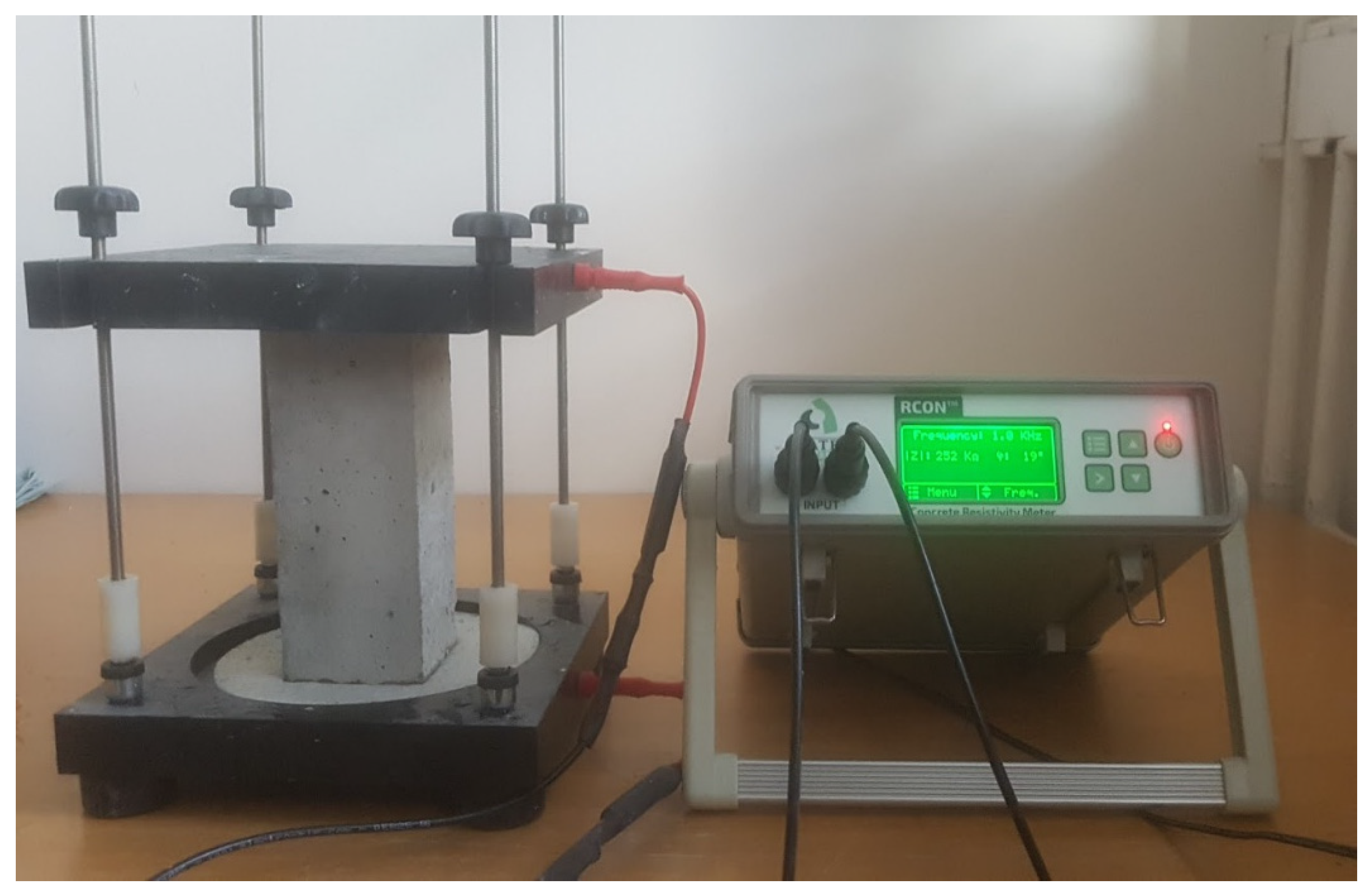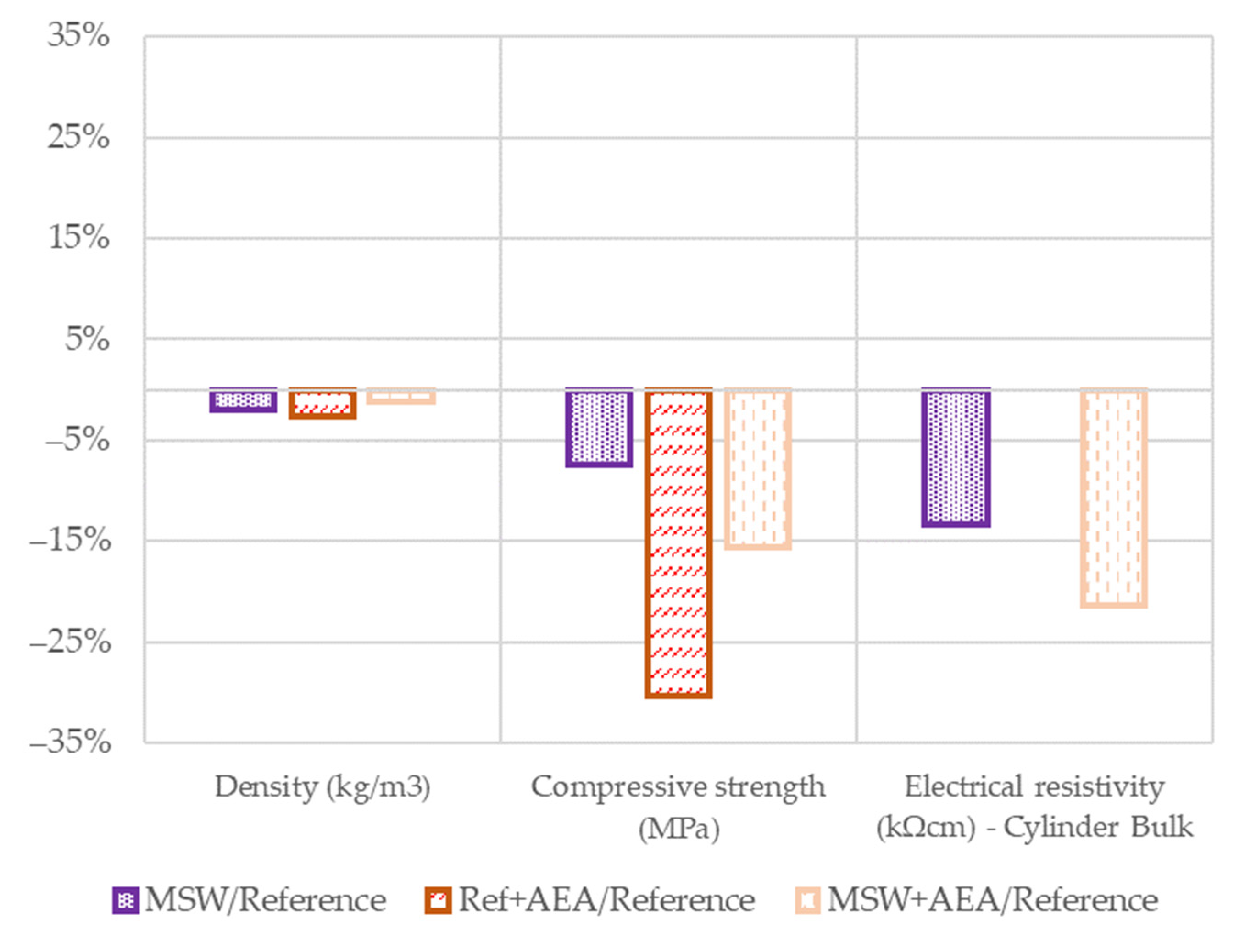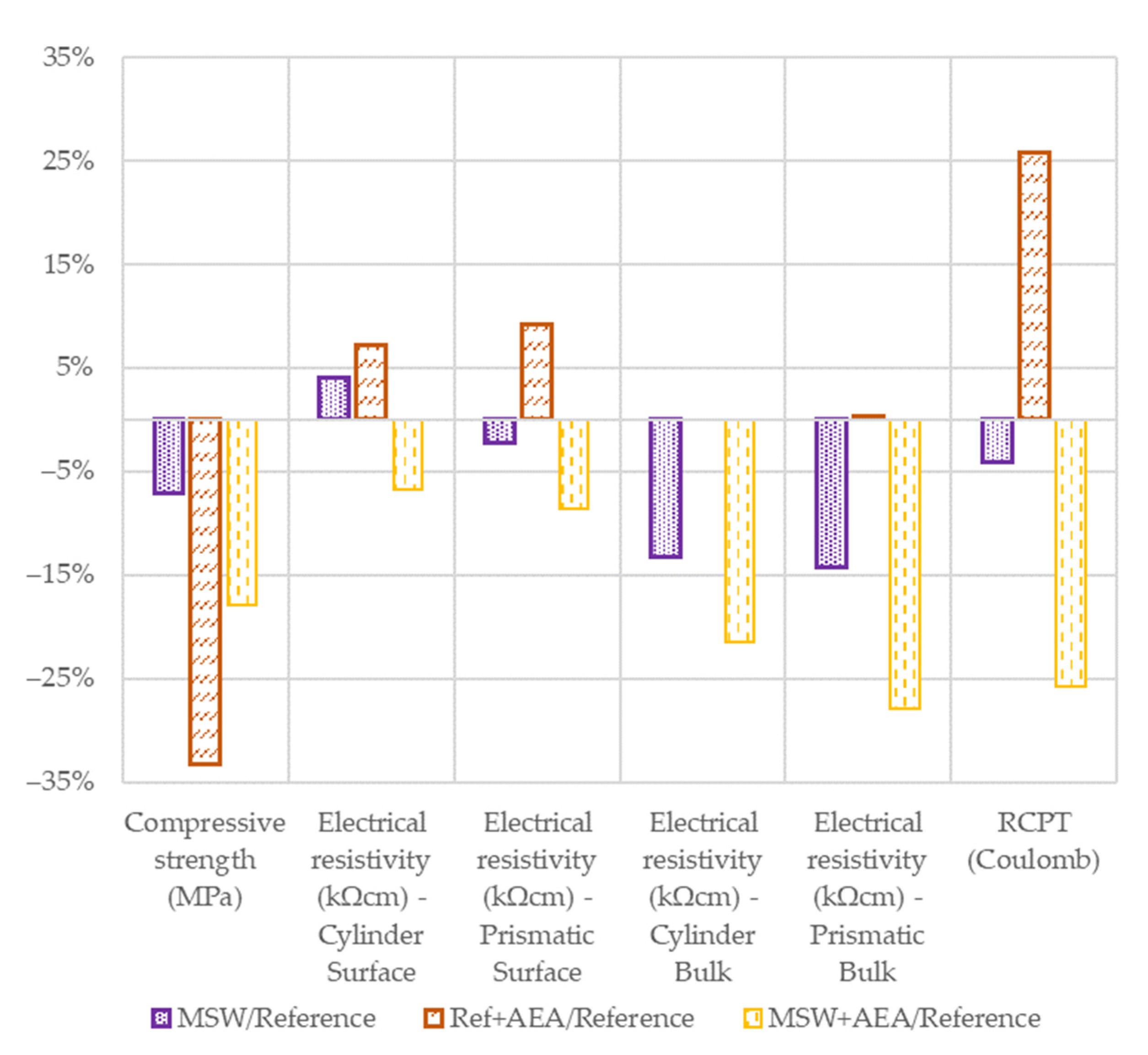Effect of Chemical Admixtures on Mechanical and Degradation Properties of Metallurgical Sludge Waste Concrete
Abstract
:1. Introduction
2. Materials and Methods
2.1. Metallurgical Sludge Waste
2.2. Concrete Compositions
2.3. Samples Preparations
2.4. Experiments
2.4.1. Density
2.4.2. Compressive Strength
2.4.3. Electrical Resistivity and Diffusion Coefficient
2.4.4. Rapid Chloride Permeability Test
3. Results
3.1. Compressive Strength
3.2. Diffusion Coefficient
3.3. Comparison of Results in 28 Days
3.4. Comparison of Results in 56 Days
3.5. Comparison of Results in 91 Days
4. Conclusions
- All concrete mixes show an improvement of parameters over time and to a very similar extent. The MSW does not have a negative effect on the progress of the degradation or strength parameters.
- The compressive strength of the reference concrete with AEA is the lowest, by about 30%. The strength of MSW and MSW + AEA concrete is lower by about 8% and 15%, respectively, compared to the reference concrete. Thus, AEA in combination with MSW has a lower negative impact than the addition of AEA to the concrete alone.
- The resistance of the MSW concrete against the aggressive substances after 91 days is about 16% lower and after 224 days is about 10% lower than the resistance of reference concrete. AEA has a slight but positive effect on the diffusion coefficient of the reference concrete. On the other hand, AEA has a negative effect on MSW concrete in terms of the diffusion coefficient, which decreases over time.
Author Contributions
Funding
Institutional Review Board Statement
Informed Consent Statement
Data Availability Statement
Acknowledgments
Conflicts of Interest
References
- Hrabova, K.; Teply, B.; Vymazal, T. Sustainability Assessment of Concrete Mixes. IOP Conf. Ser. Earth Environ. Sci. 2020, 444, 012021. [Google Scholar] [CrossRef]
- Assi, L.; Carter, K.; Deaver, E.; Anay, R.; Ziehl, P. Sustainable Concrete: Building a Greener Future. J. Clean. Prod. 2018, 198, 1641–1651. [Google Scholar] [CrossRef]
- Malešev, M.; Radonjanin, V.; Marinković, S. Recycled Concrete as Aggregate for Structural Concrete Production. Sustainability 2010, 2, 1204–1225. [Google Scholar] [CrossRef] [Green Version]
- Suzuki, M.; Seddik Meddah, M.; Sato, R. Use of Porous Ceramic Waste Aggregates for Internal Curing of High-Performance Concrete. Cem. Concr. Res. 2009, 39, 373–381. [Google Scholar] [CrossRef]
- Ogrodnik, P.; Szulej, J.; Franus, W. The Wastes of Sanitary Ceramics as Recycling Aggregate to Special Concretes. Materials 2018, 11, 1275. [Google Scholar] [CrossRef] [PubMed] [Green Version]
- Toutanji, H.A. The Use of Rubber Tire Particles in Concrete to Replace Mineral Aggregates. Cem. Concr. Compos. 1996, 18, 135–139. [Google Scholar] [CrossRef]
- Ramadevi, K.K.; Manju, R. Experimental Investigation on the Properties of Concrete with Plastic PET (Bottle) Fibres as Fine Aggregates. J. Emerg. Technol. Adv. Eng. 2012, 2, 42–46. [Google Scholar]
- Paldyna, J.; Krasnodebska-Ostrega, B.; Kregielewska, K.; Kowalska, J.; Jedynak, L.; Golimowski, J.; Grobelski, T.; Farbiszewska-Kiczma, J.; Farbiszewska, T. The Assessment of Environmental Pollution Caused by Mining and Metallurgy Wastes from Highly Polluted Post-Industrial Regions in Southern Poland. Environ. Earth Sci. 2013, 68, 439–450. [Google Scholar] [CrossRef] [Green Version]
- Fangaj, E.; Ali, A.A.; Güngör, F.; Bektaş, S.; Ceyhan, A.A. The Use of Metallurgical Waste Sludge as a Catalyst in Hydrogen Production from Sodium Borohydride. Int. J. Hydrogen Energy 2020, 45, 13322–13329. [Google Scholar] [CrossRef]
- Shekhovtsov, V.V.; Skripnikova, N.K.; Semenovykh, M.A.; Volokitin, O.G. Anorthite-Containing Building Ceramic Using Metallurgical Sludge Waste. Glass Ceram. 2021, 78, 237–241. [Google Scholar] [CrossRef]
- Alwaeli, M.; Gołaszewski, J.; Niesler, M.; Pizoń, J.; Gołaszewska, M. Recycle Option for Metallurgical Sludge Waste as a Partial Replacement for Natural Sand in Mortars Containing CSA Cement to Save the Environment and Natural Resources. J. Hazard. Mater. 2020, 398, 123101. [Google Scholar] [CrossRef] [PubMed]
- Pizoń, J.; Gołaszewski, J.; Alwaeli, M.; Szwan, P. Properties of Concrete with Recycled Concrete Aggregate Containing Metallurgical Sludge Waste. Materials 2020, 13, 1448. [Google Scholar] [CrossRef] [PubMed] [Green Version]
- Powers, T.C. The Air Requirement of Frost-Resistant Concrete. Proc. Highw. Res. Board 1949, 29, 184–211. [Google Scholar]
- Piekarczyk, A.; Łaźniewska-Piekarczyk, B. Impact of Self-Compacting Concrete Admixtures on Frost Resistance and Compressive Strength—Commensurability of Frost Resistance Criteria. Materials 2021, 14, 2922. [Google Scholar] [CrossRef] [PubMed]
- Gawlicki, M.; Czamarska, D. Effect of ZnO on the Hydration of Portland Cement. J. Therm. Anal. 1992, 38, 2157–2161. [Google Scholar] [CrossRef]
- BS EN 12390-7; Testing Hardened Concrete Part 7: Density of Hardened Concrete; BSI Standards Publication. British Standards Institution: London, UK, 2019.
- EN 12390-3; BSI Testing Hardened Concrete Part 3: Compressive Strength of Test Specimens. British Standards Institution: London, UK, 2002.
- AASHTO T358; Standard Method of Test for Surface Resistivity Indication of Concrete’s Ability to Resist Chloride Ion Penetration. AASHTO: Washington, DC, USA, 2013.
- Manual for RCON Giatec Scientific. Available online: https://www.giatecscientific.com/products/concrete-ndt-devices/rcon-bulk-resistivity/ (accessed on 1 February 2022).
- ASTM Standard C1760; Standard Test Method for Bulk Electrical Conductivity of Hardened Concrete. ASTM: Philadelphia, PA, USA, 2012; Volume I, pp. 1–5.
- Lehner, P.; Hrabová, K. Relationship of Time-Dependent Parameters from Destructive and Non-Destructive Tests of Structural Concrete. Mathematics 2022, 10, 460. [Google Scholar] [CrossRef]
- Bentz, D.P.; Garboczi, E.J.; Lu, Y.; Martys, N.; Sakulich, A.R.; Weiss, W.J. Modeling of the Influence of Transverse Cracking on Chloride Penetration into Concrete. Cem. Concr. Compos. 2013, 38, 65–74. [Google Scholar] [CrossRef]
- Konečný, P.; Lehner, P.; Ghosh, P.; Morávková, Z.; Tran, Q. Comparison of Procedures for the Evaluation of Time Dependent Concrete Diffusion Coefficient Model. Constr. Build. Mater. 2020, 258, 119535. [Google Scholar] [CrossRef]
- ASTM C1202; Standard Test Method for Electrical Indication of Concrete’s Ability to Resist Chloride Ion Penetration. American Society for Testing and Materials: Philadelphia, PA, USA, 2012; pp. 1–8. [CrossRef]
- Raczkiewicz, W.; Grzmil, W.; Zapała-Sławeta, J. Impact of the Air-Entrained Concrete with the Blast-Furnace Slag Cement on the Intensity of Reinforcement Corrosion Process. MATEC Web Conf. 2018, 163, 05010. [Google Scholar] [CrossRef]






| Fe2O3 | SiO2 | CaO | MgO | Al2O3 | Mn | P2O5 | Fe(II) |
| 21.85 | 6.65 | 13.56 | 1.34 | 1.65 | 0.60 | 0.19 | 20.91 |
| Na2O | K2O | Zn | S | C | Pb | Cl− | Ign. Loss. |
| 0.17 | 0.28 | 2.00 | 0.33 | 10.10 | 0.23 | 0.06 | 18.59 |
| Label | Cement CEM I 42.5 R (kg/m3) | Water (kg/m3) | Natural Fine Aggregate (kg/m3) | Natural Coarse Aggregate (kg/m3) | Metallurgical Sludge Waste (kg/m3) | Superplasticizer (%/cem) | Air-Entraining Admixture (%/cem) |
|---|---|---|---|---|---|---|---|
| Reference | 380 | 200 | 448 | 1342 | 0 | 0 | 0 |
| MSW | 380 | 200 | 314 | 1342 | 134 | 0.92 | 0 |
| Ref + AEA | 380 | 200 | 448 | 1342 | 0 | 0 | 0.30 |
| MSW + AEA | 380 | 200 | 314 | 1342 | 134 | 0.92 | 0.48 |
| Time Point | Material Characteristic | Reference | MSW | Ref + AEA | MSW + AEA | ||
|---|---|---|---|---|---|---|---|
| 28 days | Density (kg/m3) | 2345 | 2298 | 2285 | 2319 | ||
| Compressive strength (MPa) | 55.63 | 51.75 | 42.7 | 48.12 | |||
| Electrical resistivity (kΩcm) | Bulk | Cylinder | 5.1 | 4.5 | 5.1 | 4.2 | |
| Time Point | Material Characteristic | Reference | MSW | Ref + AEA | MSW + AEA | ||
|---|---|---|---|---|---|---|---|
| 56 days | Compressive strength (MPa) | 60.45 | 56.46 | 45.36 | 51.27 | ||
| Electrical resistivity (kΩcm) | Surface | Cylinder | 11.8 | 12.3 | 12.8 | 11.1 | |
| Prismatic | 11.6 | 11.3 | 12.8 | 10.7 | |||
| Bulk | Cylinder | 5.6 | 4.9 | 5.6 | 4.6 | ||
| Prismatic | 5.5 | 4.8 | 5.5 | 4.3 | |||
| RCPT (Coulomb) | 2746 | 2636.5 | 3698 | 2182.5 | |||
| Time Point | Mixture Label | Reference | MSW | Ref + AEA | MSW + AEA | ||
|---|---|---|---|---|---|---|---|
| 91 days | Compressive strength (MPa) | 55.63 | 51.75 | 42.7 | 48.12 | ||
| Electrical resistivity (kΩcm) | Bulk | Cylinder | 5.1 | 4.5 | 5.1 | 4.2 | |
Publisher’s Note: MDPI stays neutral with regard to jurisdictional claims in published maps and institutional affiliations. |
© 2022 by the authors. Licensee MDPI, Basel, Switzerland. This article is an open access article distributed under the terms and conditions of the Creative Commons Attribution (CC BY) license (https://creativecommons.org/licenses/by/4.0/).
Share and Cite
Lehner, P.; Horňáková, M.; Pizoń, J.; Gołaszewski, J. Effect of Chemical Admixtures on Mechanical and Degradation Properties of Metallurgical Sludge Waste Concrete. Materials 2022, 15, 8287. https://doi.org/10.3390/ma15238287
Lehner P, Horňáková M, Pizoń J, Gołaszewski J. Effect of Chemical Admixtures on Mechanical and Degradation Properties of Metallurgical Sludge Waste Concrete. Materials. 2022; 15(23):8287. https://doi.org/10.3390/ma15238287
Chicago/Turabian StyleLehner, Petr, Marie Horňáková, Jan Pizoń, and Jacek Gołaszewski. 2022. "Effect of Chemical Admixtures on Mechanical and Degradation Properties of Metallurgical Sludge Waste Concrete" Materials 15, no. 23: 8287. https://doi.org/10.3390/ma15238287






